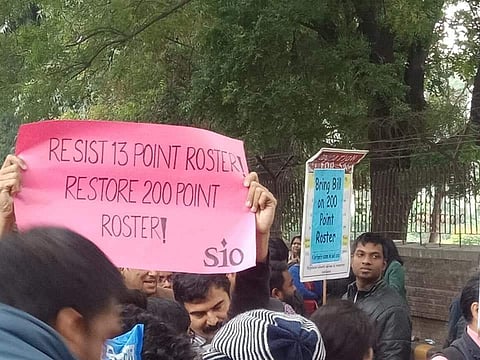

A lot has been said about the 13 point roster system and how students in JNU and other universities have been protesting against it. If you've not quite grasped what it means and what the implications are, we are going to break it down for you. Here is everything you need to know about the 13 point roster system and what the students and teachers are protesting for.
What is the new roster system?
A new roster system known as the 13 point roster system has been proposed. The 13 point roster system takes each department as a unit and implements the recruitment and reservation policy for teachers keeping the department as a unit. In the previously accepted 200 point system, the reservation and recruitment took place taking the entire university as a single unit.
Why are students and teachers protesting the new roster system?
The new roster system will drastically impact the representation of SC/ST/OBC and other marginalised communities.
How are the two systems different?
In the 200 point roster system, 99 posts were reserved for the SC, ST and OBC communities and 101 posts were for the unreserved. Under this roster, in case there is a deficit of reserved seats in one department, it could be compensated by more people from the reserved communities in other departments in the university.
In the 13 point system, the first, second, third, fifth, and sixth posts will be unreserved in a department, while the fourth will reserved for OBCs, the seventh will be reserved for SCs, the 14th post will be reserved for STs, and the eighth and 12th for OBCs, while the ninth, 10th and 11th will be unreserved.
Where does the problem lie?
The sizes of departments are very small all over India and most of the departments have less than 10 faculties position. Very few departments can be found where more than 14 positions are available. Therefore, in case of very small departments where there are less than 14 faculty positions, it becomes very difficult for the reservation of all SC/ST/OBC together.
In case of departments where there are only 4 positions available, no reserved seats will be created ever. Similarly, for departments with less than seven faculty positions, there will be no SC and ST position. And in departments with less than 14 faculty positions, there will be no ST faculty.
According to the report submitted by BHU to the HRD Ministry last year, if the university were to use the 13 point roster, posts reserved for SCs would be reduced by half, those for STs by almost 80%, and those for OBC teachers by 30%.
How will the new 10 percent reservation change things?
Now, if the 10 percent reservation for the economically backward is implemented, the SC, ST and OBC teachers could be completed wiped out from all central universities.
Do the protestors want to go back to the 200 point roster?
The students and teachers believe that the 200 point roster has not been implemented properly in any university which is why the upper castes continue to dominate and maintain the status-quo in knowledge production. They do not believe that a 200 point roster is doing the minority communities justice either but believe that it should be implemented properly.
So what is the alternative?
The protestors are demanding 50 percent reservation which the Indian constitution grants to all socially and educationally deprived communities.
